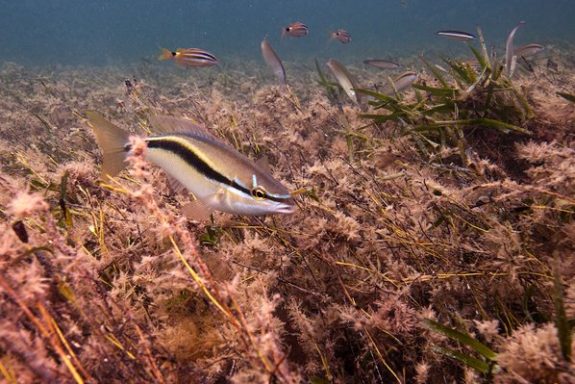Seagrass paves the way for a carbon-neutral Rottnest

Edith Cowan University Media Release
The stunning turquoise bays of Rottnest Island could be key to a carbon-neutral future for Perth’s favourite island getaway, according to new research from Edith Cowan University (ECU) and The University of Western Australia.
For the first time researchers have accurately measured the amount of carbon dioxide being absorbed by the seagrass meadows that fringe the island.
About 810 tonnes of carbon dioxide are being absorbed annually by the seagrass meadows – around 22 per cent of Rottnest’s total annual carbon emissions.
Dr Oscar Serrano from ECU’s School of Science said the research lays the groundwork for a greener future at Perth’s favourite holiday spot.
“Quantifying the amount of carbon dioxide being absorbed by these ecosystems is an important first step to potentially offset the island’s carbon dioxide emissions through conservation and restoration of seagrass meadows,” he said.
“Carbon dioxide absorbed by marine ecosystems is known as ‘blue carbon’ and has huge potential to offset carbon emissions and contribute to climate change mitigation and adaptation.
“Seagrass absorbs carbon dioxide up to 40 times faster than tropical rainforests and they have an amazing ability to store that carbon in their soils for thousands of years.”
Conservation for a cause
Camila Bedulli from the University of Western Australia co-authored the paper and said seagrass meadows also provided an important habitat for many species of fish, turtles and dugongs, as well as helping to prevent coastal erosion.
“Seagrass meadows are fragile and can easily be damaged by storms, marine heatwaves associated with climate change or human development such as moorings and dredging,” she said.
“When that happens, the carbon dioxide stored in their soils is released back into the atmosphere.”
Dr Serrano said it was extremely important seagrass meadows around Rottnest Island, and elsewhere in Australia, were protected and any damage restored.
“By protecting and restoring these important ecosystems, we’re helping to preserve our precious marine environments,” he said.
A green attraction
ECU tourism expert Associate Professor Sean Kim said a ‘clean green’ image would be a positive marketing tool for Rottnest Island, especially for international tourists.
“Rottnest Island has huge potential to become a pristine tourist destination compared to the many island destinations that have been adversely affected by from large-scale tourism development,” he said.
The research was published in Frontiers in Marine Science and can be accessed at the journal’s webpage.
Background: The role of blue carbon
- Australia is home to around 10 per cent of the world’s blue carbon ecosystems.
- In Australia it’s estimated there is four times more carbon sequestered in soil beneath marine ecosystems over a given area than in terrestrial environments.
- Coastal vegetated ecosystems account for 50 per cent of carbon dioxide sequestered by the oceans, despite covering just 0.2 per cent of its total area.
- Restoring just 10 per cent of blue carbon ecosystems lost in Australia since European settlement could generate more than $US 11 million per year in carbon credits.
- Conserving blue carbon ecosystems under threat could be worth $US 22-31 million per year in carbon credits.
Like what we do at The AIMN?
You’ll like it even more knowing that your donation will help us to keep up the good fight.
Chuck in a few bucks and see just how far it goes!
Your contribution to help with the running costs of this site will be gratefully accepted.
You can donate through PayPal or credit card via the button below, or donate via bank transfer: BSB: 062500; A/c no: 10495969










2 comments
Login here Register here-
DrakeN
-
Brad Black
Return to home pageBut, But, But…Just look at how all that seagrass washed up by the stormy seas onto beaches in the SouthWest where it is stinkingly inconveniencing the coastal dwellers by ruining their opportunities for swimming, boating and fishing.
” ‘ay orta ban it!”
The failure of the interventions and attempts at reshaping the coast for the benefit of human ‘recreational activities’ is conveniently ignored by most of the complainants and, rather than undoing the damage, they are intent on undertaking more coastal engineering to try to remedy the damage already caused.
Doing the same thing in hope of a different result?
Sheer stupidity.
You forgot to mention property values, DrakeN! Damn Mother Nature spoiling the fun.